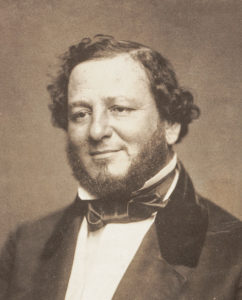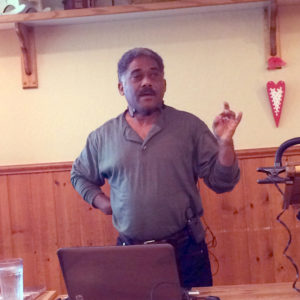Walter Day presents a DVD about the “Battle of Spotsylvania Court House”
The DVD will be shown starting at 12:15, so please have your lunch by then.

The DVD will be shown starting at 12:15, so please have your lunch by then.
Description of the presentation to be provided.
Description of the presentation to be provided.
At the outbreak of the Civil War, as Southern white men went off to fight, everyone knew they could count on the labor and loyalty of their slaves back home. Or could they?
Lincoln’s Emancipation Proclamation has been criticized for only freeing the slaves in the rebel states but not in the loyal slave states. It is said that it did not really free any slaves at all. Or did it?
Would it surprise you to know that tens of thousands of slaves were already emancipated before the Emancipation Proclamation?
Come join us to hear the fascinating story of the demise of slavery during the Civil War, and how decisive this was to the war’s outcome.
 Tom Roza of the South Bay Round Table has recently completed writing his first book on the Civil War. It was published last summer and is entitled Windows to the Past: A Virginian’s Experience in the Civil War. He will present the story of how he wrote the book and what it took to get it published. Tom applied his 50+ years as a Civil War historian to write this novel from a Southern perspective. He worked for 8 months with a professional editor from Austin, TX, on story flow and character development. It is available on Amazon.com and KDP eBook sites. Here is a link to the book on Amazon.com: link
Tom Roza of the South Bay Round Table has recently completed writing his first book on the Civil War. It was published last summer and is entitled Windows to the Past: A Virginian’s Experience in the Civil War. He will present the story of how he wrote the book and what it took to get it published. Tom applied his 50+ years as a Civil War historian to write this novel from a Southern perspective. He worked for 8 months with a professional editor from Austin, TX, on story flow and character development. It is available on Amazon.com and KDP eBook sites. Here is a link to the book on Amazon.com: link
 Judah Benjamin is scarcely remembered today. And yet, Jefferson Davis’s wife Varina Howell Davis stated that he would meet with President Davis for hours every day to discuss Confederate government matters. Judah Benjamin was known as “The brains of the Confederacy.” During the Civil War, Judah Benjamin, Jefferson Davis, and Varina Howell Davis formed a close friendship that lasted the rest of their lives. But when Jefferson Davis wrote his memoirs at the end of his life, he only made the briefest mention of this man. Why was this? And Judah Benjamin’s life story after the Civil War was so remarkable, it would be unbelievable if it weren’t actually true.
Judah Benjamin is scarcely remembered today. And yet, Jefferson Davis’s wife Varina Howell Davis stated that he would meet with President Davis for hours every day to discuss Confederate government matters. Judah Benjamin was known as “The brains of the Confederacy.” During the Civil War, Judah Benjamin, Jefferson Davis, and Varina Howell Davis formed a close friendship that lasted the rest of their lives. But when Jefferson Davis wrote his memoirs at the end of his life, he only made the briefest mention of this man. Why was this? And Judah Benjamin’s life story after the Civil War was so remarkable, it would be unbelievable if it weren’t actually true.
Abby Eller joined the Redwood City Civil War Round Table in July of this year. She and her husband Dave live in Menlo Park. Abby has been an American history buff ever since high school. In 2013 she joined Historic Union Cemetery Association based here in Redwood City.
The plight of the Japanese Americans during World War II has been well chronicled in the past, but the lives of Japanese-Americans in Japan during this same era is almost unknown to many people. Perhaps you can peek into that era from Chimi’s family tale. She was born in 1939 to Hideo and Michiko Naganuma in Los Angeles; they were called back to Japan in 1940, intending to return to the United States, but the attack on Pearl Harbor in 1941 had put everything in the pause mode. The Naganuma family spent the war years as Americans in Japan. Chimi finished her high school education in Japan in 1959, then came back to the States to go to college. After college, she was hired by Pan Am as a stewardess for her language skills in Japanese, Chinese, and English. During her time of employment with Pan Am, Chimi met Ken and they have been here raising their daughter Catherine. This is a continuation of the January meeting topic.
The plight of the Japanese Americans during World War II has been well chronicled in the past, but the lives of Japanese-Americans in Japan during this same era is almost unknown to many people. Perhaps you can peek into that era from Chimi’s family tale. She was born in 1939 to Hideo and Michiko Naganuma in Los Angeles; they were called back to Japan in 1940, intending to return to the United States, but the attack on Pearl Harbor in 1941 had put everything in the pause mode. The Naganuma family spent the war years as Americans in Japan. Chimi finished her high school education in Japan in 1959, then came back to the States to go to college. After college, she was hired by Pan Am as a stewardess for her language skills in Japanese, Chinese, and English. During her time of employment with Pan Am, Chimi met Ken and they have been here raising their daughter Catherine.
 The Civil War was also a war between two cultures, Celtic and English (again) and each had cultural influences on the attitudes toward war and how it was to be conducted. Jim’s presentation highlighted the cultural differences and identify their impacts on conduct of the Civil War.
The Civil War was also a war between two cultures, Celtic and English (again) and each had cultural influences on the attitudes toward war and how it was to be conducted. Jim’s presentation highlighted the cultural differences and identify their impacts on conduct of the Civil War.